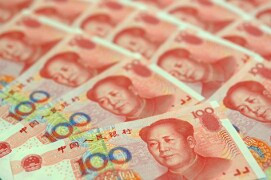
The Chinese yuan is weakening against a basket of currencies to start the trading week, driven by new data that shows exports posted a double-digit decline last month. The ongoing US-China trade discussions lingered in the background as both sides negotiate over the yuan and exchange rates.
According to the National Bureau of Statistics of China, the worldâs second-largest economy witnessed its export industry suffer the worst month in three years. Because of a cooling global economy and a trade war with the US, Chinese exports fell 21% in February compared to the same time a year ago.
The data surprised investors because Chinese exports reported an unexpected rebound in the previous month, which was mostly attributed to companies completing orders ahead of the Lunar New Year.
Due to tariffs on approximately $250 billion worth of Chinese products, the value of goods shipped to the worldâs largest economy tumbled much more sharply than for other major markets.
President Donald Trump has stated that both countries are âvery, very closeâ to striking a new trade agreement. Reaffirming previous reports, the president said he plans to meet with President Xi Jinping for a âsigning summitâ at the end of March. However, Terry Brandstad, the US ambassador to China, noted that âa date hasnât been finalized, though he stated that âsignificant progressâ has been made.
So, what is holding up the trade talks? According to several reports, it appears to be about monetary policy.
The US government is pushing China to commit to stabilizing the yuan. While the Peopleâs Bank of China (PBOC) has made it clear that it has intended to keep the currency stable for quite some time, Beijing is pushing back about the one-sided demand.
PBOC Governor Yi Gang and Vice Commerce Minister Wang Shouwen demanded that currency enforcement must be âtwo way, fair and equal.â
The two sides discussed issues on the yuan including the need to abide by previous commitments made by the G-20 nations including not to engage in competitive depreciation and to communicate closely on currency issues.
The negotiators discussed the necessity to respect the autonomy of each otherâs monetary policy, a market-oriented foreign exchange mechanism and the disclosure of information according to International Monetary Fund standards.
President Trump has accused China of suppressing the yuan for years, but the numbers suggest that up until the recent collapse, the yuan had been appreciating.
The USD/CNY currency pair rose 0.07% to 6.7264, from an opening of 6.7216, at 17:54 GMT on Monday. The EUR/CNY climbed 0.13% to 7.5595, from an opening of 7.5500.
If you have any questions, comments or opinions regarding the Chinese Yuan,
feel free to post them using the commentary form below.